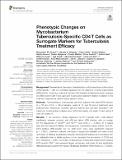Files in this item
Phenotypic changes on Mycobacterium tuberculosis-specific CD4 T cells as surrogate markers for tuberculosis treatment efficacy
Item metadata
| dc.contributor.author | Ahmed, Mohamed I. M. | |
| dc.contributor.author | Ntinginya, Nyanda E. | |
| dc.contributor.author | Kibiki, Gibson | |
| dc.contributor.author | Mtafya, Bariki A | |
| dc.contributor.author | Semvua, Hadija | |
| dc.contributor.author | Mpagama, Stellah | |
| dc.contributor.author | Mtabho, Charles | |
| dc.contributor.author | Saathoff, Elmar | |
| dc.contributor.author | Held, Kathrin | |
| dc.contributor.author | Loose, Rebecca | |
| dc.contributor.author | Kroidl, Inge | |
| dc.contributor.author | Chachage, Mkunde | |
| dc.contributor.author | Both, Ulrich von | |
| dc.contributor.author | Haule, Antelmo | |
| dc.contributor.author | Mekota, Anna-Maria | |
| dc.contributor.author | Boeree, Martin J. | |
| dc.contributor.author | Gillespie, Stephen H. | |
| dc.contributor.author | Hoelscher, Michael | |
| dc.contributor.author | Heinrich, Norbert | |
| dc.contributor.author | Geldmacher, Christof | |
| dc.contributor.author | Pan African Consortium for the Evaluation of Antituberculosis Antibiotics (PanACEA) | |
| dc.date.accessioned | 2018-10-10T16:30:06Z | |
| dc.date.available | 2018-10-10T16:30:06Z | |
| dc.date.issued | 2018-09-28 | |
| dc.identifier | 256162851 | |
| dc.identifier | 95cf5b93-d98a-447f-a973-b03c65b6af84 | |
| dc.identifier | 000445920900001 | |
| dc.identifier | 85054892786 | |
| dc.identifier.citation | Ahmed , M I M , Ntinginya , N E , Kibiki , G , Mtafya , B A , Semvua , H , Mpagama , S , Mtabho , C , Saathoff , E , Held , K , Loose , R , Kroidl , I , Chachage , M , Both , U V , Haule , A , Mekota , A-M , Boeree , M J , Gillespie , S H , Hoelscher , M , Heinrich , N , Geldmacher , C & Pan African Consortium for the Evaluation of Antituberculosis Antibiotics (PanACEA) 2018 , ' Phenotypic changes on Mycobacterium tuberculosis -specific CD4 T cells as surrogate markers for tuberculosis treatment efficacy ' , Frontiers in Immunology , vol. 9 , 2247 . https://doi.org/10.3389/fimmu.2018.02247 | en |
| dc.identifier.issn | 1664-3224 | |
| dc.identifier.other | RIS: urn:2F5862A65E2AFF22656A22605DE4DF3C | |
| dc.identifier.other | ORCID: /0000-0001-6537-7712/work/54819103 | |
| dc.identifier.uri | https://hdl.handle.net/10023/16180 | |
| dc.description | This work was supported by the European & Developing Countries Clinical Trials Partnership (EDCTP) (PanACEA, grant numbers IP.2007.32011.011, IP.2007.32011.012, IP.2007.32011.013), by the German Ministry for Education and Research (BMBF; Grant No. 01KA0901) by the European Commission, DG XII, INCO-DC (grant ICA-CT-2002-10048) and by the German Center for Infection Research (DZIF). | en |
| dc.description.abstract | Background: The analysis of phenotypic characteristics on Mycobacterium tuberculosis (MTB)-specific T cells is a promising approach for the diagnosis of active tuberculosis (aTB) and for monitoring treatment success. We therefore studied phenotypic changes on MTB-specific CD4 T cells upon anti-tuberculosis treatment initiation in relation to the treatment response as determined by sputum culture. Methods: Peripheral blood mononuclear cells from subjects with latent MTB infection (n=16) and aTB (n=39) at baseline, week 9, 12 and 26 (end of treatment) were analyzed after intracellular interferon gamma staining and overnight stimulation with tuberculin. Liquid sputum cultures were performed weekly until week 12 and during 4 visits until week 26. Results: T cell activation marker expression on MTB-specific CD4 T cells differed significantly between subjects with aTB and latent MTB infection with no overlap for the frequencies of CD38pos and Ki67pos cells (both p < 0.0001). At 9 weeks after anti-TB treatment initiation the frequencies of activation marker (CD38, HLA-DR, Ki67) positive MTB-specific, but not total CD4 T cells, were significantly reduced (p < 0.0001). Treatment induced phenotypic changes from baseline until week 9 and until week 12 differed substantially between individual aTB patients and correlated with an individual's time to stable sputum culture conversion for expression of CD38 and HLA-DR (both p < 0.05). In contrast, the frequencies of maturation marker CD27 positive MTB-specific CD4 T cells remained largely unchanged until week 26 and significantly differed between subjects with treated TB disease and latent MTB infection (p = 0.0003). Discussion: Phenotypic changes of MTB-specific T cells are potential surrogate markers for tuberculosis treatment efficacy and can help to discriminate between aTB (profile: CD38pos, CD27low), treated TB (CD38neg, CD27low), and latent MTB infection (CD38neg, CD27high). | |
| dc.format.extent | 13 | |
| dc.format.extent | 4185426 | |
| dc.language.iso | eng | |
| dc.relation.ispartof | Frontiers in Immunology | en |
| dc.subject | TAM-TB assay | en |
| dc.subject | Tuberculosis | en |
| dc.subject | Treatment monitoring | en |
| dc.subject | Mycobacterium tuberculosis-specific T cells | en |
| dc.subject | Serial sputum culture | en |
| dc.subject | Biomarker | en |
| dc.subject | QR180 Immunology | en |
| dc.subject | DAS | en |
| dc.subject | SDG 3 - Good Health and Well-being | en |
| dc.subject.lcc | QR180 | en |
| dc.title | Phenotypic changes on Mycobacterium tuberculosis-specific CD4 T cells as surrogate markers for tuberculosis treatment efficacy | en |
| dc.type | Journal article | en |
| dc.contributor.institution | University of St Andrews. School of Medicine | en |
| dc.contributor.institution | University of St Andrews. Infection and Global Health Division | en |
| dc.contributor.institution | University of St Andrews. Global Health Implementation Group | en |
| dc.contributor.institution | University of St Andrews. Gillespie Group | en |
| dc.contributor.institution | University of St Andrews. Biomedical Sciences Research Complex | en |
| dc.contributor.institution | University of St Andrews. Infection Group | en |
| dc.identifier.doi | 10.3389/fimmu.2018.02247 | |
| dc.description.status | Peer reviewed | en |
This item appears in the following Collection(s)
Items in the St Andrews Research Repository are protected by copyright, with all rights reserved, unless otherwise indicated.

